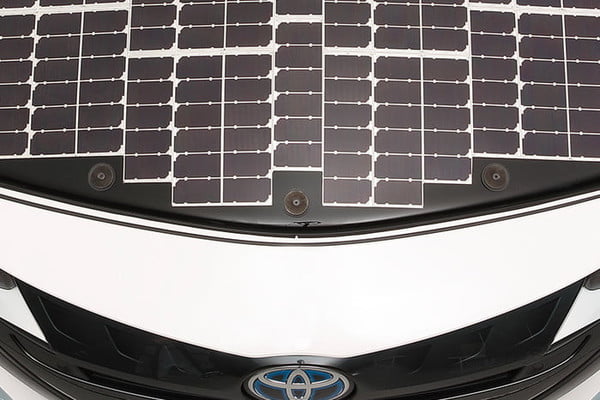Toyota throws super high-efficiency cells on its new Prius Prime – Just weeks after the debut of Lightyear One, Toyota has decided to make a solar car of their own, at least as much of a solar car as can be made. At 34% efficiency, the cells are able to add a total of 27 miles to the car’s total range, just a tick under the 30-40 offered by Lightyear One. However, Toyota previously released a solar-equipped Prius in Japan only in 2016 and that model only offered 4 extra miles of range on 22.5% efficiency. Furthermore, the new model’s solar panels can charge it as it drives, while the previous model had to be stationary. Our take: We aren’t sure who is making these cells, though images suggest that they are thin-film, and at a reported 34% these are likely Gallium Arsenide – which is typically deployed for spacecraft and other applications where cost is no barrier. Source: Digital Trends
McKinsey projects NY State solar and storage to 2040 – “In the past year, several US states have announced 100 percent clean-power targets—meaning complete reliance on low-carbon sources such as wind and solar—to be achieved over the next 20 to 30 years. The European Union hopes to go even further: it wants to decarbonize almost its whole economy—not just the power sector—by 2050… The state of New York provides an interesting case study that could prove relevant to other markets, given its level of ambition, its customer and policy trajectory, and the physical characteristics of its current power system. In 2018, 41 percent of the electricity generated in the state came from fossil fuels, almost all of it gas and dual-fuel (oil and gas) plants; 32 percent from nuclear power, and 21 percent from hydropower. There are long-term issues associated with each of these sources.” Source: McKinsey.com
Five states choose solar, wind and batteries over gas – A new analysis by World Resources Institute finds that due to lower costs, utilities and regulators are choosing to deploy renewables instead of gas plants. The paper explores recent decisions in Arizona, California, Colorado, Nevada and Virginia, finding that the time of natural gas as a “bridge fuel” is largely over. Source: World Resources Institute
Glendale power plant replacement plan – Glendale, California’s aging power plant may be getting an upgrade sooner, rather than later. The Glendale Water & Power Commission has recommended a plan wherein the natural gas plant is replaced by a mix of batteries, solar and wind. Local renewable energy advocates aren’t totally on-board, however, as the plan includes keeping on-line five internal-combustion engines that run on natural gas at the plant. Source: LA Times
POWERHOME Solar CEO wins award – “EY recently announced that Jayson Waller, CEO of POWERHOME Solar, a leading solar energy installer, has received the Entrepreneur of The Year® 2019 Award in the Emerging Services category in the Southeast. Waller was selected by an independent panel of judges and presented with the award at a special gala event at the Coca-Cola Roxy in Atlanta on Thursday, June 27, 2019… The annual Entrepreneur of the Year Awards recognizes business leaders excelling in innovation, financial performance and personal commitment to their businesses and communities. Since 1986, EY has honored entrepreneurs whose ingenuity, spirit of innovation and discipline have been driving their companies’ success, transformed their industries and made a positive impact in their communities.” Source: POWERHOME Solar
Standard Solar helps finance largest solar project of any Minnesota city – A whopping 1.5 MW have been put on-line in Brooklyn Park, Minnesota, happily homed between the city’s Community Activity Center, police station, central fire station and water treatment plant. In addition to the installation, the city also entered into several solar garden agreements with Xcel Energy, lifts Brooklyn Park to 100% sustainable energy for city facilities including buildings, streetlights and sewer lift stations. Taxpayers are expected to save $60,000 in electricity in 2020 and more than $5.5M over 25 years. Source: Standard Solar
Charlie Coggeshall joins EQ Research – “EQ Research announced today the addition of Charlie Coggeshall as a Senior Policy Analyst. Charlie’s renewable energy policy and regulatory expertise includes more than ten years of experience in the public, private and non-profit sectors. Prior to joining EQ Research, Charlie was a consultant for the Coalition for Community Solar Access, and was instrumental in driving the design and implementation of Oregon’s community solar program.” Source: EQ Research
And finally, we have a video of the construction of Standard Solar’s 1.5 MW solar project in Brooklyn Park, Minnesota.
This content is protected by copyright and may not be reused. If you want to cooperate with us and would like to reuse some of our content, please contact: editors@pv-magazine.com.










By submitting this form you agree to pv magazine using your data for the purposes of publishing your comment.
Your personal data will only be disclosed or otherwise transmitted to third parties for the purposes of spam filtering or if this is necessary for technical maintenance of the website. Any other transfer to third parties will not take place unless this is justified on the basis of applicable data protection regulations or if pv magazine is legally obliged to do so.
You may revoke this consent at any time with effect for the future, in which case your personal data will be deleted immediately. Otherwise, your data will be deleted if pv magazine has processed your request or the purpose of data storage is fulfilled.
Further information on data privacy can be found in our Data Protection Policy.